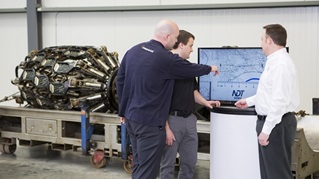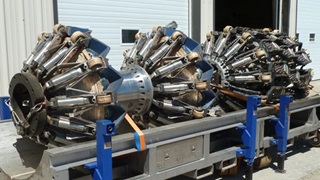Smart Pigs, Safe Pipes (Part 1): Getting down to the finer details
High-definition pipeline inspection tools can identify pinhole-sized features
They are the eyes and the ears of proactive pipeline maintenance.
And there isn’t much that escapes their attention.
Enbridge focuses heavily on prevention to keep our crude oil pipeline network safe. In-line inspection (ILI) tools—or “smart pigs,” to use industry jargon—are highly complex pieces of machinery that use advanced imaging technology to inspect our pipes inch by inch.
These tools are essential to our aggressive program of prevention, and they offer pinpoint accuracy for features that may require follow-up maintenance.
“It’s giving pipeline operators the confidence to manage any potential pipeline integrity risk,” says Paul Whitwell of Baker Hughes Inc., the world’s premier pipeline inspection services company.
“Our highest-definition tools have the capability of detecting pinhole-sized features, and seeing the most minute areas of metal loss,” adds Whitwell, a manager of process and pipeline services for Baker Hughes. “And our data analysis side is constantly adding, and reapplying, new information to our overall database, so we can quantify those pipeline features more accurately.”
Enbridge has entrusted Baker Hughes with these robust ILI-based pipeline diagnoses since 1998. In that time, Baker Hughes has performed more than 400 pipeline inspections across Enbridge’s pipeline network, producing more than 70,000 kilometers’ worth of inspection data.
Using Magnetic Flux Leakage (MFL) and ultrasonic technologies, Baker Hughes’ suite of ILI tools assesses pipelines for:
- Corrosion, metal loss or wall thickness reduction;
- Cracking, dents or buckles;
- Pipeline movement or strain;
- Deformation; and
- Validation of cathodic protection.
During these pipeline “checkups,” ILI tools move slowly along a pipeline—which can be based onshore or offshore, carrying crude oil, gas or refined products—while collecting several hundred gigabytes of data, in some cases.
Experienced analysts use 3D visualization and thermal-mapping software to identify pipeline features, capturing the dimensions of those features as well as their precise GPS co-ordinates, says Dale Simpson, a Calgary-based account manager and Enbridge liaison on pipeline inspections.
“The real proof comes when a company follows up with a maintenance dig, and sees the features that are represented by our data-set,” says Simpson. “We also follow up with operators and verify the results from these digs—we don’t just run the tool and hand over a report.”
Watch the @enbridge blog channel for future instalments of our Smart Pigs, Safe Pipes series.










